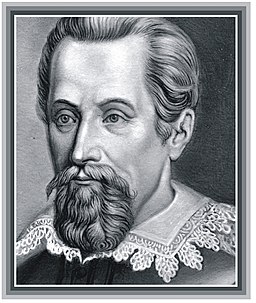
Johannes Kepler was born prematurely, on December 27, 1571, in Weil Der Stat in present day Germany. His grandfather, Sebald Kepler owned an inn where the young Kepler served guests who were openly impressed by his displays of arithmetic competence..
Kepler attended a local elementary school and later a seminary, and after that, the University of Tübingen where he was immersed in the Lutheran version of Christianity. Deeply religious, he believed that God created the universe according to mathematical laws. At Tübingen, he studied Greek, Latin, Hebrew, astronomy and mathematics. He received A’s in all but mathematics because his mathematics and astronomy professor, the eminent Michael Mästlin, recognizing Kepler’s exceptional mathematical ability, wished to prod him to a higher level of excellence. Johannes, who had been interested in astronomy from age 6, when he observed the Great Comet of 1577, studied advanced astronomy with Mästlin who introduced him to the new, heliocentric cosmological system of Copernicus.
While Galileo had been suffering persecution by the Catholic Church for promoting the heliocentric model of the solar system, the astronomers in the Protestant states of Europe were free to promote heliocentricity as long as they credited God with the design. While the invention of the telescope by the German-Dutch lensmaker Hans Lippershey in 1608 launched a new era in celestial observation, there was little understanding of the shape of the earth’s orbit or the orbits of the planets around the sun. Meanwhile, Kepler, with the assistance of the Danish astronomer Tycho Brahe, was meticulously gathering a wealth of data on the locations of the planets at various times. This data enabled Kepler to enunciate three laws of planetary motion in publications dated 1609 and 1619. Using these measurements, he determined that the planets travel in elliptical orbits around the sun and the sun is located at a focus of each ellipse.
His second law asserted that a line drawn joining a planet to its focus sweeps out equal areas in equal time intervals. His third law asserted that the square of the period of a planet’s orbit is equal to the cube of the semi-major axis of the orbit, expressed in astronomical units. Though these laws gave a much more accurate description of the solar system then had previously existed, they were empirical and it remained for scientists to discover a unifying idea that would show how Kepler’s laws of planetary motion could be logically deduced from some overarching principle.
This concept of a planetary orbit defined by physical laws, together with a statement of 3 such laws laid the groundwork for Isaac Newton’s proposed law of universal gravitation from which he deduced Kepler’s laws as logical consequences. This achievement created modern science in which the laws of nature are derived from fundamental principles.
Throughout his life, Kepler had to struggle with religious persecution, and the opposition that comes from having an opinion that differs from consensus. His lifetime struggle with the naysayers was accompanied by episodes of various illnesses and Johannes Kepler died on November 15, 1630 at the age of 58.
A mathematician at heart, Kepler once wrote, “At ubi materia, ibi Geometria. [Where this is matter, there is geometry.]”
